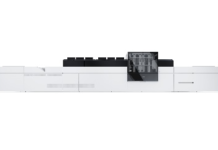According to Carl Metelerkamp, Head of Commercial Print at Canon South Africa, meeting customer demands for the progressively faster turnaround of shorter run jobs requires the right print production processes and technology, which means some form of digital production printer.
To remain competitive in today’s print production market, commercial printers need to be agile and adapt to the ongoing changes being driven predominantly by the impact of digital transformation and accelerated by the pandemic.
The increase in digitally driven on-demand printing, combined with the uptake in online ordering, has multiplied the number of print jobs at lower volumes that a print service provider (PSP) must manage and produce. In fact, according to Keypoint Intelligence research, the average number of monthly print orders received by European PSPs in 2020 surpassed 3500 – that is 117 per day.
With the quality, flexibility, productivity and cost efficiency of high-speed inkjet presses now recognised as being sufficiently mature to merit investment, more and more PSPs are adopting the technology.
One such company is CB, the leading distributor of books in The Netherlands. The production manager Dave Van’t Wout commented on the value digital inkjet has provided, ‘Digital brings enormous benefits. With offset, you produce separate sheets that then go through a production chain, from folding, gathering and sewing before a book is completely finished. Digitally printed books are created so swiftly. With digital print technology, you can have a finished book within five minutes – that’s the beauty of it.’
But a digital inkjet press in isolation is not a silver bullet and such an investment may necessitate a complete rethink and a re-engineering of a business’s production processes, especially if your business has not previously embraced digital printing on any level. There are many opportunities to achieve greater operational efficiencies, reduce costs and enter new markets with digital inkjet, but there are also a lot of variables to consider.
However, anyone with experience of running a manufacturing operation understands the challenges of keeping an operation running efficiently and maximising the efficiencies of production. To identify areas where processes could be improved, manufacturing managers regularly carry out an analysis of the 4Ms – manpower, method, machine and materials – the most important factors involved in the production process. In taking this approach, it’s clear that being ‘lean’ is not just about a single piece of equipment or software, but is really about looking at all variables within the operation, at how people are behaving as much as how well equipment is performing.
As most industrial manufacturing lines have already done, print production lines are optimising more and more of the processes involved by automating them with software or machinery that requires minimal or no human assistance or intervention. Take order intake, for example – the workflow efficiency of many business models (e.g. on-demand printing) strongly depends on the integration of web-based and standardized order management tools, whether these are open platforms for B2C or closed platforms for B2B.
But the key element of these type of e-commerce platforms is the seamless interaction between the online storefront and the production workflows. Typically, if this integration is managed well, the benefits of these automated order management solutions will follow: reduced order errors, reduced time on order processing and issue solving, visibility of order processes, faster processing cycle times and improved efficiency in order fulfilment.
That’s just one example, but it can be mirrored and needs to be mirrored throughout the manufacturing journey as there is no point in developing an online portal, for example, which would allow thousands of orders to be taken if there is no automation or technology to handle those jobs. In the same way, while inkjet technology itself can provide a significant boost in quality, speed, flexibility and cost effectiveness, unless the workflow before and after the press has been optimised, a PSP is not going to get the best return from their investment.
We therefore recommend that PSPs take a holistic approach to process optimisation and, from a Canon perspective, we often find that starting at the end and working backwords can be a more valuable approach. First look at what you are trying to produce and then start to consider how that product can be best manufactured – not just in the most cost-effective way, but delivered with all the necessary parameters, which might include, for example, quality, a price point and a certain finishing requirement. The key is to challenge previous assumptions and be prepared to be self-critical and this process should be an ongoing one that is regularly monitored, tested and reviewed.
Mike Hughes is Managing Director at Latcham Direct, a UK commercial printer that has invested in inkjet. To PSPs considering the same move, he offers the following advice, ‘First and foremost, realise that an inkjet device alone won’t give you everything. It is part of the solution that drives efficiency – but all parts of the manufacturing process need to be considered. For example, we needed to consider the finishing capabilities to make sure these were aligned and could manage the workload and prevent bottlenecks. We needed to consider the flexibility requirements in terms of the application types, and our customer requirements in terms of quality, run lengths, personalisation, finishing and turnaround times.
We also needed to have a partner that fully understood the journey we wanted to take and who could help work alongside us with the expertise and knowledge to ensure we delivered the right success. We spent a lot of time not just understanding the technology and how it would fit and what benefits we would get, but we also analysed the service capability and support mechanisms in place.’
CANON SOUTH AFRICA
CZA-Marketing@canon.co.za
http://www.canon.co.za





















